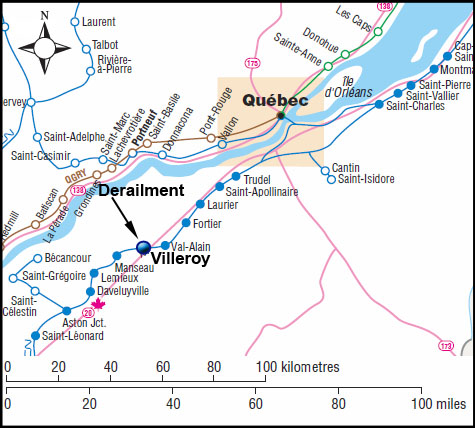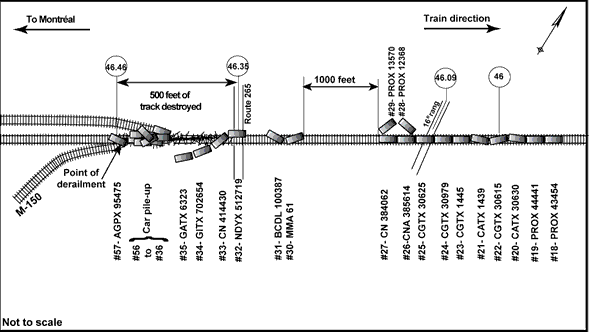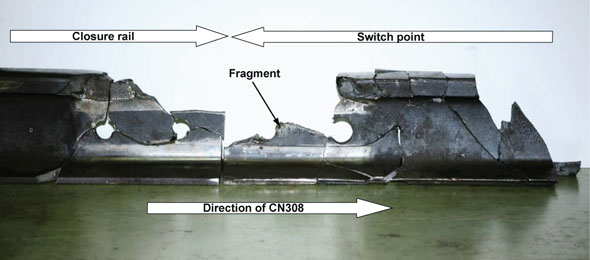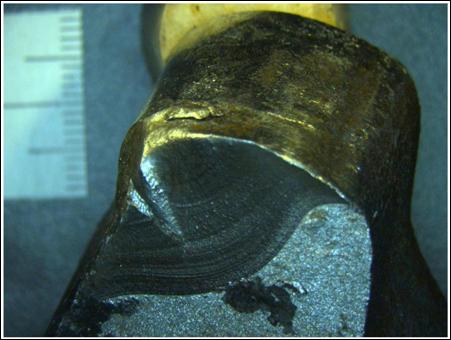Main-track train derailment
Canadian National
Freight train M-308-31-31
Mile 46.46, Drummondville Subdivision
Villeroy, Quebec
The Transportation Safety Board of Canada (TSB) investigated this occurrence for the purpose of advancing transportation safety. It is not the function of the Board to assign fault or determine civil or criminal liability. This report is not created for use in the context of legal, disciplinary or other proceedings. See Ownership and use of content. Masculine pronouns and position titles may be used to signify all genders to comply with the Canadian Transportation Accident Investigation and Safety Board Act (S.C. 1989, c. 3).
Summary
On 31 December 2008, at 2315 eastern standard time, 33 cars derailed at Mile 46.46 of the Canadian National Drummondville Subdivision, near Villeroy, Quebec. A switch heater was damaged, causing approximately 2000 gallons of propane to be released. About 50 homes were evacuated. Approximately 500 feet of track was destroyed. There were no injuries and no permanent damage to the environment.
Ce rapport est également disponible en français.
Factual information
The accident
On 31 December 2008, Canadian National (CN) freight train M-308-31-31 (the train) departed Turcot Yard, Quebec, and proceeded eastward destined to Joffre, Quebec. The train consisted of 3 locomotives and 115 cars (70 loads and 45 empties), weighed approximately 10 800 tons and was 7000 feet long. The crew was made up of a locomotive engineer and a conductor. They were familiar with the territory, met fitness and rest standards and were qualified for their respective positions.
At 2314,Footnote 1 while passing through the town of Villeroy (see Figure 1), a train-initiated emergency brake application occurred when the locomotive was at Mile 46.0. The train was travelling at 50 mph with the throttle in position 7. The lead locomotive came to rest at Mile 45.61. The conductor inspected the train and found that 33 cars had derailed. Two main-track turnouts and the switch heater were damaged. The switch heater gas line was severed, causing propane gas to be released. The sky was overcast and the temperature was -20°C.
The fire department was advised by local residents of the accident, arrived on the scene shortly thereafter, and established a safety perimeter. Firefighters assessed the risks and immediately evacuated approximately 70 residents from the area as a precaution. Residents were allowed to return to their homes at about five o'clock in the morning.
Site examination
The derailment area covers a distance of approximately 2500 feet, from turnout M150 at Mile 46.46 to Mile 46.00 (see Figure 2). The section includes two public grade crossings: the Route 265 crossing at Mile 46.35 and the 16e Rang crossing at Mile 46.09. The derailed equipment consisted of seven empty tank cars, six empty box cars and twenty loaded covered hopper cars.
The first derailed cars, the 20th to 22nd cars, remained upright on the roadbed, each with a derailed truck. The following cars, the 23rd to 27th cars, remained on the track. The 28th and 29th cars rolled off their trucks and derailed to the north side of the track. The following cars, the 30th to 35th cars, separated from the front of the train and derailed near the Route 265 crossing. The rest of the derailed cars piled up between the crossing and turnout M150.
All of the derailed equipment was examined; no pre-derailment defects were found on the cars. Examination of the wheels on the 18th, 19th, 23rd, 24th and 25th tank cars showed that the cars derailed, rolled on the ballast and lifted onto the rails. The train had passed over several wayside inspection systems (WIS), the last one at Mile 51.7 of the Drummondville Subdivision, without setting off any alarms.
Turnout M150 is a CN No. 12, 132-pound, hand-operated turnout (CN Standard Plan Drawing TS-012) with the switch points facing east (see Appendix A). The Samson switch point was manufactured in 1976 by Algoma Steel. The switch point and the straight closure rail had less than 2 mm of wear.
Track damage started at turnout M150 and continued eastward for approximately 500 feet. Around the switch heel block, the eastern end of the closure rail was broken, and the switch point was broken into several pieces. Several broken components were recovered; however, the rail head and the upper part of the web were missing (see Photo 1).
TSB laboratory examination (report LP 005/2009) of the rail fragments showed that horizontal cracks had developed between the joint bolt holes. Some fracture surfaces had flattened, worn surfaces caused by the friction of fragments created by the fracture. Most of the fractures were caused by overstress; no evidence of fatigue was noted. The crushed rail head on the ends of the rail fragments indicates that, due to the pounding of the wheels, the rail fragmented from the heel block to the switch point.
The inside splice bar of the southern switch heel block joint was broken in two. A fatigue crack originated from a notch on the side in contact with the rail and spread to the upper part of the splice bar just below the rail head (see Photo 2).
The edges of the heel block that were in contact with the rails had a smooth, polished surface, indicating long-term wear from friction. The four switch heel block joint bolts showed wear. Three of them were sheared and had pre-existing cracks due to fatigue. The low temperature at the time of the accident may have contributed to reducing steel toughness, thus facilitating overstress fractures.
The metallurgical analysis did not reveal any manufacturing defects or anomalies such as inclusions or porosities. The switch point showed an average hardness of 273 BHN (Brinell hardness) and the closure rail showed a hardness of 305 BHN.
Track information
The Drummondville Subdivision consists of a single main track that extends from Mile 5.6 near Saint-Romuald, Quebec, to Mile 125.1 near Sainte-Rosalie, Quebec. Train movements are governed by the Centralized Traffic Control System as authorized by the Canadian Rail Operating Rules and are supervised by a rail traffic controller located in Montréal, Quebec. The track is Class 5 according to the Railway Track Safety Rules (TSR) approved by Transport Canada (TC). The maximum permissible track speed is 100 mph for passenger trains and 65 mph for freight trains. Rail traffic consists of 14 freight and 10 passenger trains per day, with an annual tonnage of approximately 39 million gross tons.
In the derailment area, the track consisted of 132-pound continuous welded rail manufactured in 2004, laid on double-shouldered tie plates, fastened to the ties with five spikes. There were approximately 3200 hardwood ties per mile. There were rail anchors at each tie. The ballast was approximately 12 inches deep, with 16- to 18-inch shoulders. The ballast consisted primarily of crushed rock ranging from 1½ to 3 inches in diameter.
All inspections were performed in accordance with the TSR. Four inspections were conducted in 2008 using a track geometry car. The most recent inspection, conducted on 12 November 2008, showed no defects in the Villeroy area.
Ten continuous track inspections for internal rail defects were conducted in 2008. The basic inspection system consists of a vehicle equipped with transducers, an ultrasonic signal generator, a signal processor and a host computer. The system can detect internal defects of less than ½ inch in the rail head and web, but it does not cover splice bars or bolts. No defects were detected in the derailment area during the last inspection on 01 December 2008. Examination of the test files showed that, in the area around the southern switch heel block, the surface of the rail was clean and in good condition. The only signal returns observed were generated by bolt holes.
Turnout M150 is rarely used; its last monthly inspection was performed on 09 December 2008. The last regular visual inspection of the track using a hi-rail vehicle had been conducted on the same day as the derailment, and no exceptions were noted in the turnout area.
Following a derailment in Montmagny, Quebec, in January 2007, involving a broken switch heel block, CN conducted a special inspection of all the switch heel blocks in the Eastern Division. In February 2007, the switch heel block joint at turnout M150 was dismantled to verify the condition of its components. No anomalies were found.
Analysis
Neither the condition of the rolling stock nor the manner in which the train was operated is considered contributory to this accident. The analysis will focus on track component defects and track inspection.
The laboratory examination of the fractured components recovered in the switch heel block area suggested a looseness of the assembly that had been present for some time. The repetitive motion caused by the passing of each truck wore down the components and initiated fatigue cracks in the bolts and the inside splice bar of the joint. Cracks spread due to overstress and fractured the splice bar and three of the four joint bolts, weakening the joint assembly and causing the fracture of the other components. The rail fracture spread in the rail web and caused a gradual fragmentation of the rail head. Once the rail head had separated, the wheel flanges moved against the other components, causing dislocation of the assembly and derailment of the train.
The fatigue crack in the splice bar started on the side in contact with the rail and propagated upwards. The crack was invisible because it was covered by the rail head. In addition, the continuous inspection of internal rail defects does not examine splice bars; as a result, the crack could not have been found during one of the many turnout inspections.
Even though the switch heel block joint at the turnout was completely dismantled and inspected in February 2007 and regular inspections were conducted by experienced CN inspectors, no defects were found. Furthermore, the most recent inspections did not reveal the loosened components.
In the course of both monthly and regular visual inspections, it is common to kick the bolts with the safety boot tips to check whether they are loose and how much they have loosened. Loose bolts tend to move easily. However, this method is not always effective because, when holes in different components are not aligned or when the weather is cold, bolts can stay stuck. Because the presence of loose bolts and the degree of looseness are not always properly assessed, there is an increased risk that a weakening of the switch heel block joint assembly may go unnoticed. The use of an appropriate wrench, or some other effective means, would have enabled an inspector to check bolt tightness.
Findings
Findings as to causes and contributing factors
- The train derailed when the switch heel block joint failed under the weight of the train.
- Loosening of the bolts contributed to a weakening of the joint assembly, causing component separation and fracture.
- Regular inspections did not reveal the loose bolts.
Finding as to risk
- Because the presence of loose bolts and the degree of looseness are not always properly assessed, there is an increased risk that a weakening of the switch heel block joint assembly may go unnoticed.
Other findings
- The use of an appropriate wrench, or some other effective means, would have enabled an inspector to check bolt tightness.
- The crack in the splice bar was covered by the rail head and could therefore not be detected in the course of the many turnout inspections.
This report concludes the Transportation Safety Board's investigation into this occurrence. Consequently, the Board authorized the release of this report on .




